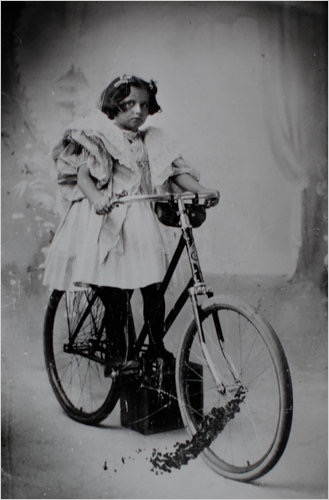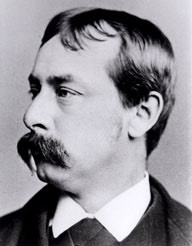Alas, like so many headlines crafted by the Fourth Estate, the one for this story is misleading. No precocious little newsies ever bellowed those words on a street corner. No pedestrians ever forked over a penny for proof that Santa Claus existed. The story about Santa Claus was stuck inside the paper on the editorial page as a “third-column” item, which meant it was filler. It did not appear at Christmas. The column appeared in September 1897, and its author regarded it a silly piece of fluff. The little girl who asked the question grew weary when the newspaper at first ignored her, and she then lost interest. By September she had forgotten all about it. The most famous editorial in the history of journalism was almost never written. When it was, it was hardly judged a timeless classic.
The little girl’s father had started the whole thing. Virginia O’Hanlon had just turned eight in July 1897. She surveyed the long giftless months until Christmas and began to ponder. She was at that age when a child begins to weigh the improbability of Santa Claus, and some of her more cynical friends were throwing in their two cents’ worth. Virginia asked her father one of the two questions that parents hear with dread. (The other is where babies come from.) Rather than falling back on the traditional dodge of the cornered dad — “Ask your mother” — Dr. O’Hanlon went for the brass ring. He ducked the difficult question by telling Virginia to ask the newspaper.

Virginia O'Hanlon
And not just any old newspaper. The O’Hanlon family read the Sun. It was a stolid, respectable daily that some would have called stodgy, which would have suited its editor just fine. Charles A. Dana avoided the excesses of the Roarin’ Nineties that detractors called “yellow journalism.” The Sun steered clear of the sensational stunt and avoided deliberate fabrication. Instead, a popular Sunday feature set the Sun's serious tone. It was a column called “Notes and Queries” that answered questions such as “What is the world’s fastest land animal?” and “How far is it from Paris to Provence?”
It was to “Notes and Queries” that Virginia sent her question about Santa Claus that summer in 1897. Faithful to the paper’s attitude about schmaltz, an editor tossed the letter into a bin where it languished for weeks. Finally, someone ran across it on a slow news day. To fill up an empty column, a staff writer named Frank P. Church soon had instructions to work up a little response. Church grimaced over the hackwork, but an assignment was an assignment. He took Virginia’s letter back to his desk and sketched out a draft during breaks from his real work.
Church was an unlikely man for the job. The few people he called friends never thought him the fanciful type. Twenty years earlier his failure to found a literary magazine had hammered the whimsy out of him. To pay the bills, he joined the editorial department of the Sun. He remained there for the rest of his life.
In fact, as the years passed he had more job security and a better salary than most New York newspapermen. He had a talent for measured and sometimes lyrical prose and was quick in putting it together. For two decades Church's writing was unsigned. In those days publishers didn’t want famous writers demanding higher salaries. The policy was all right by Church because it suited his nature. The anonymous opinion could be forceful. He was 58, childless, retiring, and so soft-spoken that people couldn't remember him ever expressing a forceful opinion about anything, even the weather. Rather, Frank Church trudged to the Sun building each day and let himself go at his desk. He wrote about Cuba or McKinley or the gaudy excess of the Sun’s competitors across town.
And Santa Claus. That day he had the annoying chore of writing about Santa Claus. Published after only a slight effort to polish it, Church's editorial bears all the marks of haste and extemporaneous thought. For instance, he surely didn't mean to bury the lead, but that is what he did. His first paragraph went far in revealing his pique over the exercise in itself. He spoke of the “little Minds” of both children and grownups unable to grasp truth and comprehend beauty.
Then something magical happened. The money quote, the meme, the phrase that everybody would remember, appeared in the second paragraph. As if tinkering on a piano to find an elusive melody, Church opened his second paragraph with a note that sloughed off purse-lipped disapproval. He stepped to the edge of the column’s cliff to spread wings and soar with the words: “Yes, Virginia, there is a Santa Claus.” The lines that followed were what historian W. Joseph Campbell has described as “altogether stylish, whimsical, and charming.”

Francis Pharcellus Church
At some point, polishing becomes tweaking and dulls rather than burnishes, and possibly Church had the good sense to leave his original draft alone. If that were the case, his newspaper didn't think he had written anything special. The Sun published it and moved on. The paper’s readers, however, did not. The instant it appeared Frank Church’s little essay struck a chord. At first, it was with New Yorkers. Then as papers across the country picked up the column, it charmed readers from Savannah to San Francisco, from Elmira to El Paso. “Yes, Virginia, there is a Santa Claus” was on its way to becoming part of the Christmas vernacular. It became shorthand for whimsy over cynicism. More, it became a shield from the hard realities of a world embarking on one of the worst centuries in its history.
The New York Sun didn’t realize this was happening, which is understandable. But less clear is why the newspaper took so long to discern the first-class phenomenon the little piece was. The Sun did not reprint Church’s editorial until 1902. When Frank Church died in 1906, it again appeared that Christmas, but more as a tribute to him than a Yuletide feature. In fact, The Sun republished the essay only on an occasional Christmas until the 1920s. Not until the jaded years after the First World War did the Sun begin printing Church's answer to Virginia every Christmas, doing so until the paper folded in January 1950.
Did little Virginia O’Hanlon believe Frank Church? They never met. She grew up, married, and suffered a life sadly devoid of whimsy and featuring precious little romance. Her husband ran out on her just as she was about to have their daughter. Virginia went to school and accumulated advanced degrees the way some old ladies collect cats, winding up with a Ph.D. She became a teacher and a principal and could count significant accomplishments at the end of a long career.
But the small measure of fame brought by her question to the New York Sun in 1897 never dimmed through all the years that followed. The random interview and the occasional speaking gig at this or that ladies’ luncheon were the public faces of her celebrity. But the private letters were a treat. Almost daily the mail brought little tributes and queries until the day she died at age 81 in 1971. For a few minutes, as she read the handful of such letters on any given day, she was again the little girl who had found out Santa Claus was real. She answered them all.
There were no bellowing newsies on the street corners in 1897. But here in 2016, we’ll don the ragamuffin garb, pull our caps to one side, and do some bellowing of our own. “KRINGLE IS REAL!” we shout, “READ ALL ABOUT IT.”
Here then is Virginia’s question and Mr. Church’s response transcribed from the New York Sun, September 21, 1897.
And please put the penny back in your pocket. This one’s on the house. Merry Christmas!
_____________________________________________________
We take pleasure in answering at once and thus prominently the communication below, expressing at the same time our great gratification that its faithful author is numbered among the readers of the Sun:
Dear Editor: I am 8 years old. Some of my little friends say there is no Santa Claus. Papa says, “If you see it in the Sun it’s so.” Please tell me the truth; is there a Santa Claus?
Virginia O’Hanlon.
115 West Ninety-Fifth Street.
Virginia, your little friends are wrong. They have been affected by the skepticism of a skeptical age. They do not believe except they see. They think that nothing can be which is not comprehensible by their little minds. All minds, Virginia, whether they be men’s or children’s are little. In this great universe of ours man is a mere insect, an ant, in his intellect, as compared with the boundless world about him, as measured by the intelligence capable of grasping the whole of truth and knowledge.
Yes, Virginia, there is a Santa Clause. He exists as certainly as love and generosity and devotion exist, and you know that they abound and give your life its highest beauty and glory. Alas! how dreary would be the world if there were no Santa Claus. It would be as dreary as if there were no Virginia’s. There would be no childlike faith then, no poetry, no romance to make tolerable this existence. We should have no enjoyment, except in sense and sight. The eternal light with which childhood fills the world would be extinguished.
Not believe in Santa Claus! You might as well not believe in fairies! You might get your papa to hire men to watch in all the chimneys on Christmas Eve to catch Santa Claus, but even if they did not see Santa Claus coming down, what would that prove? Nobody sees Santa Claus, but that is no sign that there is no Santa Claus. The most real things in the world are those that neither children nor men can see. Did you ever see fairies dancing on the lawn? Of course not, but that’s no proof that they are not there. Nobody can conceive or imagine all the wonders there are unseen and unseeable in the world.
You may tear apart the baby’s rattle and see what makes the noise inside, but there is a veil covering the unseen world which not the strongest man, not even the united strength of all the strongest men that ever lived, could tear apart. Only faith, fancy, poetry, love, romance, can push aside that curtain and view and picture the supernal beauty and glory beyond. Is it all real? Ah, Virginia, in all this world there is nothing else real and abiding.
No Santa Claus! Thank God! he lives, and he lives forever. A thousand years from now, Virginia, nay, ten times ten thousand years from now, he will continue to make glad the heart of childhood.